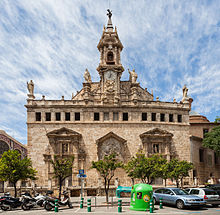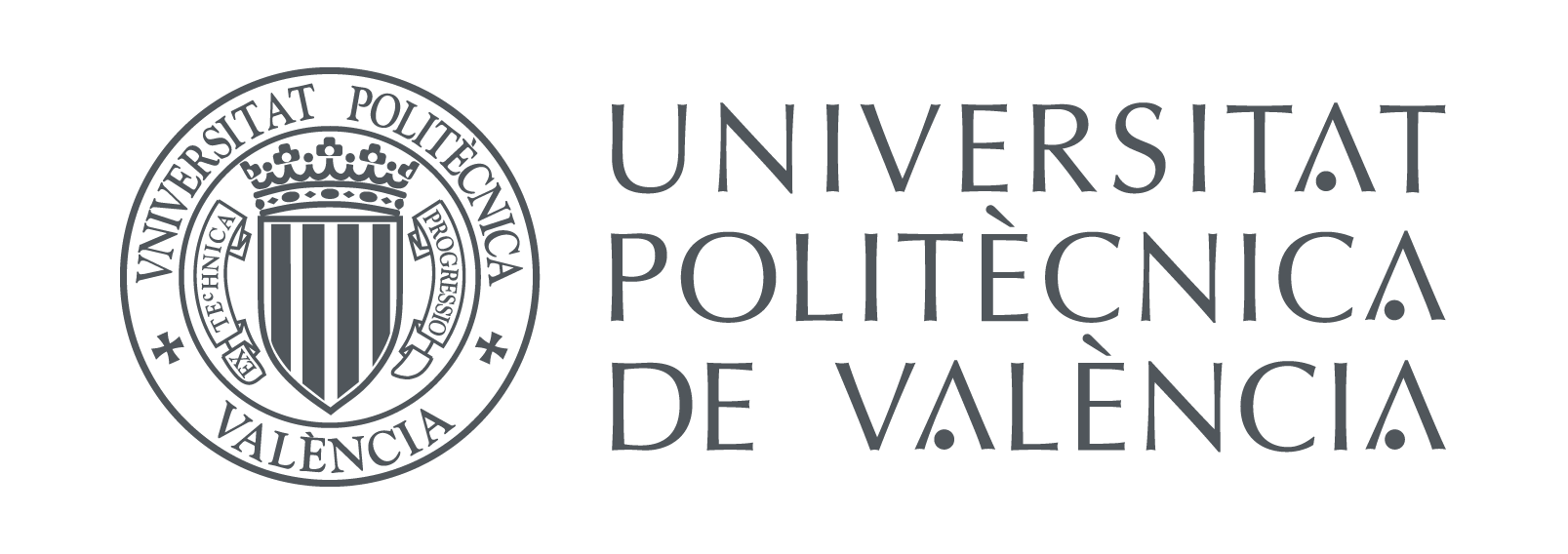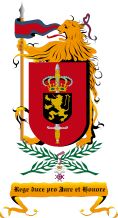Venue - UNDER CONSTRUCTION
|
Valencia
València (Valencian)
|
|
|---|---|
|
|
|
| Coordinates: 39°28′12″N 00°22′35″W / 39.47000°N 0.37639°W | |
| Country | Spain |
| Autonomous Community | Valencian Community |
| Province | Valencia |
| Comarca | Horta of Valencia |
| Founded | 138 BC |
| Districts |
19 districtes
|
| Government | |
| • Type | Ajuntament |
| • Body | Ajuntament de València |
| • Mayor | María José Catalá (since 2023) (People's Party) |
| Area | |
| • Municipality | 134.65 km2 (51.99 sq mi) |
| • Urban | 628.81 km2 (242.78 sq mi) |
| Elevation | 15 m (49 ft) |
|
Population
(2023)
|
|
| • Municipality | 792,492 |
| • Density | 5,865.1/km2 (15,191/sq mi) |
| • Urban | 1,595,000 |
| • Metro | 2,522,383 |
| Demonym(s) | Valencian •valencià, -ana (va) •valenciano, -na (es) |
| GDP | |
| • Metro | €56.413 billion (2020) |
| Time zone | UTC+01:00 (CET (GMT)) |
| • Summer (DST) | UTC+02:00 (CEST (GMT)) |
| Postcode |
46000-46080
|
| ISO 3166-2 | ES-V |
| Website | www.valencia.es |
Valencia ( Spanish: [baˈlenθja] ⓘ, officially in Valencian: València [vaˈlensia]) is the capital of the autonomous community of Valencia and the third-most populated municipality in Spain, with 809,501 inhabitants (2023). It is the capital of the province of the same name. The wider urban area comprising the neighbouring municipalities has a population of around 1.6 million, constituting one of the major urban areas on the European side of the Mediterranean Sea. It is located on the banks of the Turia, on the east coast of the Iberian Peninsula at the Gulf of Valencia, north of the Albufera lagoon.
Valencia was founded as a Roman colony in 138 BC. Islamic rule and acculturation ensued in the 8th century, together with the introduction of new irrigation systems and crops. Aragonese Christian conquest took place in 1238, and so the city became the capital of the Kingdom of Valencia. The city's population thrived in the 15th century, owing to trade with the rest of the Iberian Peninsula, Italian ports, and other Mediterranean locations, becoming one of the largest European cities by the end of the century. Already harmed by the emergence of the Atlantic World trade in detriment to Mediterranean trade in global trade networks, along with insecurity created by Barbary piracy throughout the 16th century, the city's economic activity experienced a crisis upon the expulsion of the Moriscos in 1609. The city became a major silk manufacturing centre in the 18th century. During the Spanish Civil War, the city served as the accidental seat of the Spanish Government from 1936 to 1937.
The Port of Valencia is the 5th-busiest container port in Europe and the second busiest container port on the Mediterranean Sea. The city is ranked as a Gamma-level global city by the Globalization and World Cities Research Network. Its historic centre is one of the largest in Spain, spanning approximately 169 hectares (420 acres). Due to its long history, Valencia has numerous celebrations and traditions, such as the Falles (or Fallas), which was declared a Fiesta of National Tourist Interest of Spain in 1965 and an intangible cultural heritage by UNESCO in November 2016. In 2022, the city was voted the world's top destination for expatriates, based on criteria such as quality of life and affordability.
Geography
Location


Located on the eastern coast of the Iberian Peninsula and the western part of the Mediterranean Sea, fronting the Gulf of Valencia, Valencia lies on the highly fertile alluvial silts accumulated on the floodplain formed in the lower course of the Turia River. At its founding by the Romans in 138 BC, it stood on an alluvial plain of the Turia River several kilometers from the sea.
The Albufera lagoon, located about 12 km (7 mi) south of the city proper (and part of the municipality), was originally a saltwater lagoon, but since the severing of links to the sea, it has eventually become a freshwater lagoon, progressively decreasing in size. The lagoon and its environment are used for the cultivation of rice in paddy fields, and for hunting and fishing purposes.
The Valencia City Council bought the lake from the Crown of Spain for 1,072,980 pesetas in 1911, and today it forms the main portion of the Parc Natural de l'Albufera (Albufera Nature Reserve), with a surface area of 21,120 hectares (52,200 acres). Because of its cultural, historical, and ecological value, it was declared a natural park in 1976.
Climate
The climate of Valencia is hot semi-arid (Köppen: BSh) with mild winters and hot, dry summers. According to the Siegmund/Frankenberg climate classification, Valencia has a subtropical climate.
The maximum of precipitation occurs in autumn, coinciding with the time of the year when cold drop (gota fría) episodes of heavy rainfall—associated to cut-off low pressure systems at high altitude— are common along the Western mediterranean coast. The year-on-year variability in precipitation may be, however, considerable.
Snowfall is extremely rare; the most recent occasion snow accumulated on the ground was on 11 January 1960. Valencia has one of the mildest winters in Europe, owing to its southern location on the Mediterranean Sea and the Foehn phenomenon, locally known as ponentà. The January average is comparable to temperatures expected for May and September in the major cities of northern Europe.
Its average annual temperature is 18.3 °C (64.9 °F); 22.8 °C (73.0 °F) during the day and 13.8 °C (56.8 °F) at night. In the coldest month, January, the maximum daily temperature typically ranges from 14 to 20 °C (57 to 68 °F), the minimum temperature typically at night ranges from 5 to 10 °C (41 to 50 °F). During the warmest months – July and August, the maximum temperature during the day typically ranges from 28 to 32 °C (82 to 90 °F), about 21 to 23 °C (70 to 73 °F) at night. March is transitional, the temperature often exceeds 20 °C (68 °F), with an average temperature of 19.3 °C (66.7 °F) during the day and 10.0 °C (50.0 °F) at night. December, January and February are the coldest months, with average temperatures around 17 °C (63 °F) during the day and 8 °C (46 °F) at night.
The highest and lowest temperatures recorded in the city since 1937 were 44.7 °C (112.5 °F) on 10 August 2023 and −7.2 °C (19.0 °F) on 11 February 1956, respectively.
Valencia, on average, has 2,696 sunshine hours per year, from 155 in December (average of 5 hours of sunshine duration a day) to 315 in July (average above 10 hours of sunshine duration a day). The average temperature of the sea is 14–15 °C (57–59 °F) in winter and 25–26 °C (77–79 °F) in summer. Average annual relative humidity is 65%.
| Climate data for Valencia (4 km [2 mi] from sea, altitude: 11 m.a.s.l., averages 1981–2010) | |||||||||||||
|---|---|---|---|---|---|---|---|---|---|---|---|---|---|
| Month | Jan | Feb | Mar | Apr | May | Jun | Jul | Aug | Sep | Oct | Nov | Dec | Year |
| Record high °C (°F) | 26.6 (79.9) |
29.0 (84.2) |
33.2 (91.8) |
35.2 (95.4) |
42.0 (107.6) |
39.3 (102.7) |
41.8 (107.2) |
44.5 (112.1) |
38.4 (101.1) |
35.8 (96.4) |
32.0 (89.6) |
27.3 (81.1) |
44.5 (112.1) |
| Mean daily maximum °C (°F) | 16.4 (61.5) |
17.1 (62.8) |
19.3 (66.7) |
20.8 (69.4) |
23.4 (74.1) |
27.1 (80.8) |
29.7 (85.5) |
30.2 (86.4) |
27.9 (82.2) |
24.3 (75.7) |
19.8 (67.6) |
17.0 (62.6) |
22.8 (73.0) |
| Daily mean °C (°F) | 11.9 (53.4) |
12.7 (54.9) |
14.6 (58.3) |
16.2 (61.2) |
19.0 (66.2) |
22.9 (73.2) |
25.6 (78.1) |
26.1 (79.0) |
23.5 (74.3) |
19.7 (67.5) |
15.3 (59.5) |
12.6 (54.7) |
18.3 (64.9) |
| Mean daily minimum °C (°F) | 7.1 (44.8) |
7.8 (46.0) |
9.7 (49.5) |
11.5 (52.7) |
14.6 (58.3) |
18.6 (65.5) |
21.5 (70.7) |
21.9 (71.4) |
19.1 (66.4) |
15.2 (59.4) |
10.8 (51.4) |
8.1 (46.6) |
13.8 (56.8) |
| Record low °C (°F) | −6.5 (20.3) |
−7.2 (19.0) |
−0.4 (31.3) |
1.0 (33.8) |
5.0 (41.0) |
8.5 (47.3) |
11.6 (52.9) |
12.5 (54.5) |
8.0 (46.4) |
4.1 (39.4) |
−0.8 (30.6) |
−2.8 (27.0) |
−7.2 (19.0) |
| Average precipitation mm (inches) | 37 (1.5) |
36 (1.4) |
33 (1.3) |
38 (1.5) |
39 (1.5) |
22 (0.9) |
8 (0.3) |
20 (0.8) |
70 (2.8) |
77 (3.0) |
47 (1.9) |
48 (1.9) |
475 (18.7) |
| Average precipitation days (≥ 1 mm) | 4.4 | 3.9 | 3.6 | 4.8 | 4.3 | 2.6 | 1.1 | 2.4 | 5.0 | 5.0 | 4.3 | 4.8 | 46.3 |
| Mean monthly sunshine hours | 171 | 171 | 215 | 234 | 259 | 276 | 315 | 288 | 235 | 202 | 167 | 155 | 2,696 |
| Source: Agencia Estatal de Meteorología | |||||||||||||
Culture
Valencia is known internationally for the Falles (Les Falles), a local festival held in March, as well as for paella valenciana, traditional Valencian ceramics, craftsmanship in traditional dress, and the architecture of the City of Arts and Sciences, designed by Santiago Calatrava and Félix Candela.
There are also a number of well-preserved traditional Catholic festivities throughout the year, like those of the Holy Week, which are considered some of the most colourful in Spain.
Valencia used to be the place of the Formula One European Grand Prix, first hosting the event on 24 August 2008, but was dropped later at the beginning of the Grand Prix 2013 season. However, Valencia still holds the annual Moto GP race at the Circuit Ricardo Tormo, usually the last race of the season, in November.
The University of Valencia (officially Universitat de València Estudi General), founded in 1499, is one of the oldest surviving universities in Spain and the oldest in the Valencian Community. It was listed as one of the four leading Spanish universities in the 2011 Shanghai Academic Ranking of World Universities.
In 2012, Boston's Berklee College of Music opened a satellite campus at the Palau de les Arts Reina Sofia, their first and only international campus outside the U.S. Since 2003, Valencia has also hosted the music courses of Musikeon, the leading musical institution in the Spanish-speaking world.
Food
Valencia is known for its gastronomic culture. The paella, a simmered rice dish with meat (usually chicken or rabbit) or seafood, was born in Valencia. Other traditional dishes of Valencian gastronomy include fideuà, arròs a banda, arròs negre (black rice), fartons, bunyols, Spanish omelette, pinchos or tapas and calamares (squid).
Valencia was also the birthplace of the cold xufa beverage known as orxata, popular in many parts of the world, including the Americas.
Main sights
Major monuments include Valencia Cathedral, the Torres de Serrans, the Torres de Quart (ca:Torres de Quart), the Lonja de la Seda (declared a World Heritage Site by UNESCO in 1996), and the Ciutat de les Arts i les Ciències (City of Arts and Sciences), an entertainment-based cultural and architectural complex designed by Santiago Calatrava and Félix Candela. The Museu de Belles Arts de València houses a large collection of paintings from the 14th to the 18th centuries, including works by Velázquez, El Greco, and Goya, as well as an important series of engravings by Piranesi. The Institut Valencià d'Art Modern (Valencian Institute of Modern Art) houses both permanent collections and temporary exhibitions of contemporary art and photography.
Architecture
The ancient winding streets of the Barrio del Carmen contain buildings dating to Roman and Arab times. The Cathedral and its bell tower El Miguelete, built between the 13th and 15th centuries, are primarily of Valencian Gothic style but contains elements of Baroque and Romanesque architecture. Beside the cathedral is the Gothic Basilica of the Virgin (Basílica De La Mare de Déu dels Desamparats). The 15th-century Serrans and Quart towers are part of what was once the wall surrounding the city.
UNESCO has recognised the Silk Exchange market (La Llotja de la Seda), erected in early Valencian Gothic style, as a World Heritage Site. The Central Market (Mercat Central) in Valencian Art Nouveau style, is one of the largest in Europe. The main railway station Estació Del Nord is built in Valencian Art Nouveau (a Spanish version of Art Nouveau) style.
World-renowned (and city-born) architect Santiago Calatrava produced the futuristic City of Arts and Sciences (Ciutat de les Arts i les Ciències), which contains an opera house/performing arts centre, a science museum, an IMAX cinema/planetarium, an oceanographic park and other structures such as a long covered walkway and restaurants. Calatrava is also responsible for the bridge named after him in the centre of the city. The Palau de la Música de València (Music Palace) is another noteworthy example of modern architecture in Valencia.
-
The gothic courtyard of the Palace of the Admiral of Aragon (Palau de l'Almirall)
-
Convento de Santo Domingo (1300-1640)
-
Llotja de la Seda (Silk Exchange, interior)
-
Mercat de Colon in Valencian Art Nouveau style
-
Mercat Central (Central Market), in Valencian Art Nouveau style
-
One of the few arch-bridges that links the cathedral with neighboring buildings. This one built in 1666.
-
Monastery of San Miguel de los Reyes built between 1548 and 1763
-
L’Hemisfèric (IMAX Dome cinema) and Palau de les Arts Reina Sofia
-
Assut de l'Or Bridge and L'Àgora behind.
-
Sant Joan de l'Hospital church built in 1316 (except for a Baroque chapel)
-
Mudéjar (Christian) baths Banys de l'Almirall (1313-1320)
-
The Museum of Fine Arts of Valencia, is the museum with the second largest amount of paintings in Spain, after Prado Museum
Cathedral

The Valencia Cathedral was called Iglesia Major in the early days of the Reconquista, then Iglesia de la Seu (Seu is from the Latin sedes, i.e., (archiepiscopal) See), and by virtue of the papal concession of 16 October 1866, it was called the Basilica Metropolitana. It is situated in the centre of the ancient Roman city where some believe the temple of Diana stood.[citation needed] In Gothic times, it seems to have been dedicated to the Holy Saviour; the Cid dedicated it to the Blessed Virgin; King James I of Aragon did likewise, leaving in the main chapel the image of the Blessed Virgin, which he carried with him and is reputed to be the one now preserved in the sacristy. The Moorish mosque, which had been converted into a Christian Church by the conqueror, was deemed unworthy of the title of the cathedral of Valencia, and in 1262 Bishop Andrés de Albalat laid the cornerstone of the new Gothic building, with three naves; these reach only to the choir of the present building. Bishop Vidal de Blanes built the chapter hall, and James I added the tower, called El Miguelete in Castilian Spanish or Torre del Micalet in the Valencian language because it was blessed on St. Michael's day in 1418.[citation needed] The tower is about 58 metres (190 feet) high and is topped with a belfry (1660–1736).
In the 15th century the dome was added and the naves extended back of the choir, uniting the building to the tower and forming a main entrance. Archbishop Luis Alfonso de los Cameros began the building of the main chapel in 1674; the walls were decorated with marbles and bronzes in the Baroque style of that period. At the beginning of the 18th century the German Conrad Rudolphus built the façade of the main entrance. The other two doors lead into the transept; one, that of the Apostles in pure pointed Gothic, dates from the 14th century, the other is that of the Palau. The additions made to the back of the cathedral detract from its height. The 18th-century restoration rounded the pointed arches, covered the Gothic columns with Corinthian pillars, and redecorated the walls.
The dome has no lantern, its plain ceiling being pierced by two large side windows. There are four chapels on either side, besides that at the end and those that open into the choir, the transept, and the sanctuary. It contains many paintings by eminent artists. A silver reredos, which was behind the altar, was carried away in the war of 1808, and converted into coin to meet the expenses of the campaign. There are two paintings by Francisco de Goya in the San Francesco chapel. Behind the Chapel of the Blessed Sacrament is a small Renaissance chapel built by Calixtus III. Beside the cathedral is the chapel dedicated to the Our Lady of the Forsaken (Mare de Déu dels Desemparats).
The Tribunal de les Aigües (Water Court), a court dating from Moorish times that hears and mediates in matters relating to irrigation water, sits at noon every Thursday outside the Porta dels Apostols (Portal of the Apostles).
Hospital

In 1409, a hospital was founded and placed under the patronage of Santa Maria dels Innocents; to this was attached a confraternity devoted to recovering the bodies of the unfriended dead in the city and within a radius of 5 km (3.1 mi) around it. At the end of the 15th century this confraternity separated from the hospital, and continued its work under the name of "Cofradia para el ámparo de los desamparados". King Philip IV of Spain and the Duke of Arcos suggested the building of the new chapel, and in 1647 the Viceroy, Conde de Oropesa, who had been preserved from the bubonic plague, insisted on carrying out their project. The Blessed Virgin was proclaimed patroness of the city under the title of Virgen de los desamparados (Virgin of the Forsaken), and Archbishop Pedro de Urbina, on 31 June 1652, laid the cornerstone of the new chapel of this name. The archiepiscopal palace, a grain market in the time of the Moors, is simple in design, with an inside cloister and achapel. In 1357, the arch that connects it with the cathedral was built. Inside the council chamber are preserved the portraits of all the prelates of Valencia.
Medieval churches

- Sant Joan del Mercat- Gothic parish church dedicated to John the Baptist and Evangelist, rebuilt in the Baroque style after a 1598 fire. The interior ceilings were frescoed by Palomino.
- Sant Nicolau
- Santa Catalina
- Sant Esteve
El Temple (the Temple), the ancient church of the Knights Templar, which passed into the hands of the Order of Montesa and was rebuilt in the reigns of Ferdinand VI and Charles III; the former convent of the Dominicans, at one time the headquarters of the Capitan General, the cloister of which has a Gothic wing and chapter room, large columns imitating palm trees; the Colegio del Corpus Christi, which is devoted to the Blessed Sacrament, and in which perpetual adoration is carried on; the Jesuit college, which was destroyed in 1868 by the revolutionary Committee of the Popular Front, but later rebuilt; and the Colegio de San Juan (also of the Society), the former college of the nobles, now a provincial institute for secondary instruction.
Squares and gardens

The largest plaza in Valencia is the Plaça del Ajuntament; it is home to the City Hall (Ajuntament) on its western side and the central post office (Edifici de Correus) on its eastern side, a cinema that shows classic movies, and many restaurants and bars. The plaza is triangular in shape, with a large cement lot at the southern end, normally surrounded by flower vendors. It serves as ground zero during the Les Falles when the fireworks of the Mascletà can be heard every afternoon. There is a large fountain at the northern end.
The Plaça de la Mare de Déu contains the Basilica of the Virgin and the Turia fountain, and is a popular spot for locals and tourists. Around the corner is the Plaza de la Reina, with the cathedral, orange trees, and many bars and restaurants.
The Turia River was diverted in the 1960s, after severe flooding, and the old riverbed is now the Turia gardens, which contain a children's playground, a fountain, and sports fields. The Palau de la Música is adjacent to the Turia gardens and the City of Arts and Sciences lies at one end. The Valencia Bioparc is a zoo, also located in the Turia riverbed.
Other gardens in Valencia include:
- The Jardíns de Monfort (es:Jardines de Monforte)
- The Botanical Garden of Valencia (Jardí Botànic)
- The Jardins del Real or Jardins de Vivers (Del Real Gardens) are located in the Pla del Real district, on just the former site of the Del Real Palace.
Museums


-
Ciutat de les Arts i les Ciències (City of Arts and Sciences). Designed by the Valencian architect Santiago Calatrava, it is situated in the former Túria river-bed and comprises the following monuments:
- Palau de les Arts Reina Sofía, a flamboyant opera and music palace with four halls and a total area of 37,000 m2 (398,000 sq ft).
- L'Oceanogràfic, the largest aquarium in Europe, with a variety of ocean beings from different environments: from the Mediterranean, fishes from the ocean and reef inhabitants, sharks, mackerel swarms, dolphinarium, inhabitants of the polar regions (belugas, walruses, penguins), coast inhabitants (sea lions, etc. L'Oceanogràfic exhibits also smaller animals as coral, jellyfish, sea anemones, etc.
- El Museu de les Ciències Príncipe Felipe, an interactive museum of science but resembling the skeleton of a whale. It has an area of around 40,000 square metres (430,556 square feet) across three floors.
- L'Hemisfèric, an IMAX cinema (es:L'Hemisfèric)
- Museu de Prehistòria de València (Prehistory Museum of Valencia)
- Museu Valencià d'Etnologia (Valencian Museum of Ethnology)
- Blasco Ibáñez House Museum
- Institut Valencià d'Art Modern - IVAM – Centre Julio González (Valencian Institute of Modern Art)
- Museu de Belles Arts de València (Museum of Fine Arts of Valencia)
- Museu Faller (Falles Museum)
- Museu d'Història de València (Valencia History Museum)
- L'Almoina Museum (Centre Arqueològic de l'Almoina), located near the Cathedral
- Natural Science Museum of Valencia, located at Jardins del Real
- Museu Taurí de València (Bullfighting Museum)
- MuVIM – Museu Valencià de la Il·lustració i la Modernitat (Valencian Museum of Enlightenment and Modernity)
- González Martí National Museum of Ceramics and Decorative Arts, housed in the Palace of the Marqués de Dos Aguas
- Computer Museum, located within Technical School of Computer Engineering in Technical University of Valencia








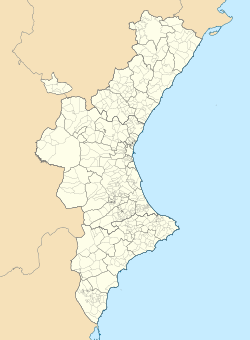




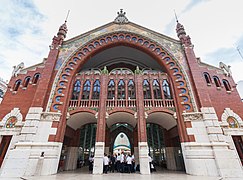






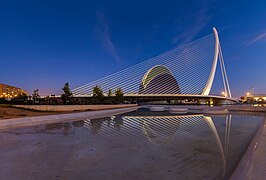


![The Museum of Fine Arts of Valencia, is the museum with the second largest amount of paintings in Spain,[5][6] after Prado Museum](https://upload.wikimedia.org/wikipedia/commons/thumb/b/b0/Qk-Antoni-Peris-detalle-06.jpg/241px-Qk-Antoni-Peris-detalle-06.jpg)

